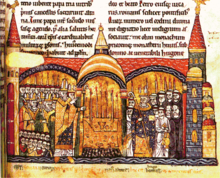Christianity in the 10th century

By the 10th century, Christianity had spread throughout much of Europe and Asia. The
Pre-scholastic theology
With the division and decline of the
Monasticism
Monastic reform movement

From the 6th century onward most of the monasteries in the West were of the
The Cluniac reform of monasteries that began in 910 placed abbots under the direct control of the pope rather than the secular control of feudal lords, thus eliminating a major source of corruption. This sparked a great monastic renewal.[2] Monasteries, convents and cathedrals still operated virtually all schools and libraries and often functioned as credit establishments promoting economic growth.[3][4]
Monastic contributions to western society included the teaching of metallurgy, the introduction of new crops, the invention of musical notation and the creation and preservation of literature.[5]
First Patriarchate of Bulgarian Church
Following two decisive victories over the Byzantines at
The Bulgarian Patriarchate was the first autocephalous Slavic Orthodox Church, preceding the autocephaly of the
On April 5, 972, Byzantine Emperor
Spread of Christianity
Poland
The "Baptism of Poland" (
Hungary
In the Middle Ages, the
Stephen promulgated Roman Catholicism as the state religion, and his successors were traditionally known as the
Kievan Rus'
The success of the conversion of the Bulgarians facilitated the conversion of other East
.After the
Between the 8th and the 13th century the area was settled by the
Timeline
- 909 Benedictinemonastery in France
- 912 - The Normans become Christian[8]
- 948? Einsiedeln Abbey of Switzerland
- 948 - The leader of the Magyarsconverts to Christianity
- 957 -
- 965 - Danish people
- 966 Mieszko I duke of Poland baptised, Poland becomes a Christian country.
- 966 -
- 984 Antipope Boniface VII, murdered Pope John XIV, alleged to have murdered Pope Benedict VI in 974
- 987 - Nestorian monks visiting China find no traces of Christian community left[11]
- 988 Baptism of Kievan Rus'
- 988 - Vladimir I[12]
- 995 - Christian missionaries from Norway begin working in Iceland
- 997 - Adalbert of Prague dies as a martyr in Prussia[13]
- 997-998 Otto III
- 999 Much speculation and fear regarding the approach of the millennium
- 1000 - Olaf Tryggvason of Norway sends Leif Erikson to Greenland to preach Christianity[14]
See also
- History of Christianity
- History of the Catholic Church
- History of the Eastern Orthodox Church
- History of Christian theology
- History of Oriental Orthodoxy
- Christianization
- Timeline of Christianity
- Timeline of Christian missions
- Timeline of the Catholic Church
- Chronological list of saints in the 10th century
Notes and references
- ^ Bibliothèque nationale de France
- ^ Duffy, Saints and Sinners (1997), pp. 88–89
- ^ Woods, How the Church Built Western Civilization (2005), p. 40
- ^ Le Goff, Medieval Civilization (1964), pp. 80–82
- ^ Woods, How the Church Built Western Civilization (2005), pp. 44–48
- ISBN 9781434458766. Retrieved 18 October 2017 – via Google Books.
- ISBN 9788884924643. Retrieved 18 October 2017 – via Google Books.
- ^ Adams, Henry. Mont Saint Michel and Chartres, Penguin Classics, 1986, p. 19
- ^ Neill, p. 76
- ^ Neill, p. 79
- ^ Neill, p. 83
- ^ Olson, p. 104
- ^ Neill, p. 94
- ^ "Leif the Lucky". Archived from the original on 2008-09-07. Retrieved 2016-02-06.
Further reading
- Lawrence, C. H. Medieval Monasticism. 3rd ed. Harlow: Pearson Education, 2001. ISBN 0-582-40427-4
- Fletcher, Richard, The Conversion of Europe. From Paganism to Christianity 371-1386 AD. London 1997.
- Padberg, Lutz v., (1998): Die Christianisierung Europas im Mittelalter, Stuttgart, Reclam (German)
